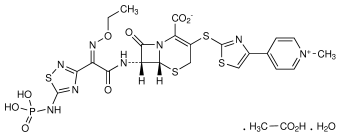
Mechanism of Action
Antimicrobial Action Ceftaroline fosamil is a fifth-generation cephalosporin with broad-spectrum bactericidal activity against many Gram-positive and Gram-negative organisms. Its activity is similar to that of cefotaxime ( Refer to ); however, it has an expanded spectrum of activity against Gram-positive bacteria that includes MRSA and multidrug-resistantStreptococcus pneumoniae. Enterococci are generally resistant, but there may be some susceptibility shown byEnterococcus faecalis. Although ceftaroline has good activity against many Gram-negative bacteria, Pseudomonas aeruginosa,Acinetobacter spp., Alcaligenes spp., andStenotrophomonas maltophilia have decreased susceptibility. Ceftaroline has poor activity against Gram-negative anaerobes such as Bacteroides fragilis and Prevotella spp., however, Gram-positive anaerobes such as Propionibacteriumspp. and Peptostreptococcus spp. are highly susceptible.
結構:

Pharmacokinetics
After infusion, ceftaroline fosamil is rapidly converted in the plasma to ceftaroline, the bio-active form of the drug. Mean peak plasma concentrations of 19 micrograms/mL have been reported after a single 600 mg dose of ceftaroline fosamil given intravenously over 1 hour. Ceftaroline is about 20% bound to plasma proteins, and in healthy patients, has a mean steady-state volume of distribution of about 20.3 litres. Ceftaroline is metabolised in small amounts to the microbiologically-inactive metabolite ceftaroline M-1 via hydrolysis of the β-lactam ring. Ceftaroline and its metabolite are excreted mainly by the kidneys, with about 88% of a dose recovered in the urine within 48 hours (mainly as unchanged drug); a small amount of drug is excreted in faeces. The elimination half-life of ceftaroline is about 2.66 hours. Ceftaroline exposure and half-life are significantly increased in renal impairment.
Adverse Effects and Precautions
As for Cefalotin Sodium ( Refer to ). Like other broad-spectrum cephalosporins (see Cefotaxime, Refer to ), ceftaroline has the potential for promoting colonisation and superinfection with resistant organisms.





 留言列表
留言列表
 線上藥物查詢
線上藥物查詢 